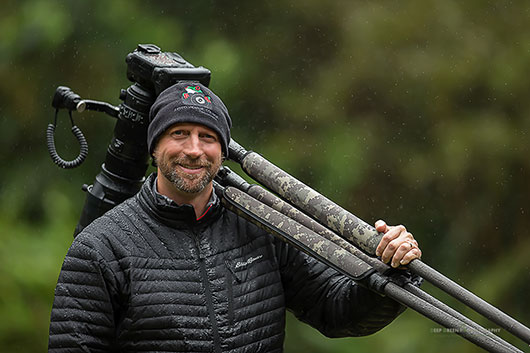The Scene
Glass frogs, named for their translucent skin, are delicate and elusive. The best conditions to find glass frogs are on rainy nights when they come out to breed in the vegetation overhanging rushing streams. I set out a few years ago on a perfect rainy night in a Costa Rican cloud forest in search of glass frogs. After hiking around for a couple of hours with a good photographer friend I was able to find one, and it was on a nice Heliconia leaf! I hoped to make a special portrait that accentuated the nighttime habits and cool transparency of glass frogs. I wanted my photo of this Emerald Glass Frog (Espadarana prosoblepon) to look otherworldly.
Camera Settings
Since I was out at night, I needed an artificial light source to take the picture. Flash is the obvious choice. Indeed, I had two flashes with me, and it’s my go to solution for much of the lighting for my rainforest work. But tonight I wanted a very particular look for my image, a spotlight kind of effect. While one can work with various barndoors and honeycomb grids to control the spread angle of light from a flash, it can be a little tricky and it can involve some experimentation. Knowing that getting exactly the right look from my flashes could take a while and stress my subject, I chose flashlights, which would allow me to get a real-time preview of my lighting and make rapid adjustments while photographing. I could get the shot I wanted pretty quickly and then let my glass frog buddy get back to looking for a mate!
After quickly making the decision to use flashlights rather than flash, I had two more issues to work through. The first was exposure; basic flash exposure in TTL mode is easy but flashlights are less predictable beforehand. Since it’s pitch black out in the forest, I would only know the correct exposure once I illuminated my subject. Though I normally work in manual mode, I decided to go with aperture priority so that my camera could adjust to slight changes in the lighting. I chose to shoot at f11 in order to give me enough—but not too much—depth of field, as I wanted some of the leaf to taper off into a blurred look. Since I was using flashlights, I wouldn’t have the motion-stopping benefits of flash. This aperture also gave me a reasonable shutter speed (1/8) at a decent ISO (800), which was important because there’s always a bit of breeze in the forest.

The second issue was how to light the frog and leaf for the mysterious look I wanted and of course how to hold everything. I used mirror lockup while shooting from a tripod while I held a cable release in one hand and one flashlight in the other. My friend held the other two flashlights. Our idea was to have the light shine mostly through the leaf, rather than directly on the frog, in order to give that green glowing look, and also to make sure that the leaf didn’t receive any flat, on-axis light. By adjusting the beam spread on the flashlights, we were able to create some cool shadows and brighter areas.

Nikon D700, Nikon 105 mm macro lens, tripod and ballhead, aperture priority mode, -2/3 exposure compensation, matrix metering, f/11, 1/8, ISO 800, cable release, 3 maglite flashlights
PROCESSING
I use Lightroom for the vast majority of my processing, and this image was no exception. I used the shadows and highlights sliders to adjust contrast and used the spot removal tool to deal with a few specks of dirt on the leaf. Processing took no more than a couple of minutes.
THE LESSON
Shooting wildlife at night is a fun and challenging experience. Learning to use both flashes and flashlights to illuminate your subjects expands your toolbox and allows you to choose the best lighting solution for a given scenario.
 About the author: Greg Basco is a professional nature photographer and environmentalist based in Costa Rica. You can view more of his work at www.deepgreenphotography.com. If you’d like to join Greg in Chile this October, visit his photo tour company’s website www.fotoverdetours.com.
About the author: Greg Basco is a professional nature photographer and environmentalist based in Costa Rica. You can view more of his work at www.deepgreenphotography.com. If you’d like to join Greg in Chile this October, visit his photo tour company’s website www.fotoverdetours.com.


Share tips, start a discussion or ask one of our experts or other students a question.
Already a member? Sign in
No Responses to “Behind the Shot: Glass Frog World”